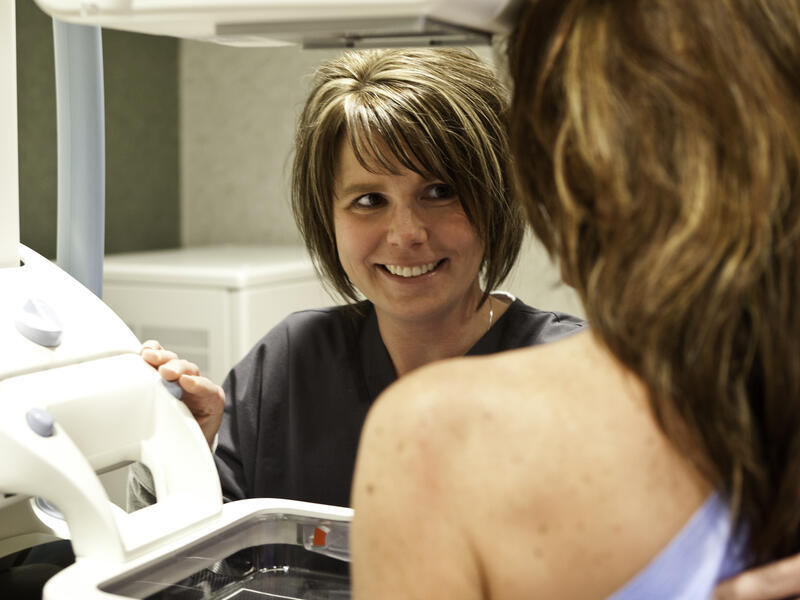At the Edith Sanford Breast Centers throughout Sanford Health’s communities, breast radiologists, oncologists and surgeons are in agreement: Patients considered at average risk for breast cancer should follow the Edith screening standard by getting an annual mammogram starting at age 40 to help catch breast cancer early, when it’s most treatable.
“There’s decades and decades of research backing up the findings that beginning screening at age 40 will save the most number of lives,” said Christina Tello-Skjerseth, M.D., chief of radiology at Edith Sanford in Bismarck, North Dakota.
“In my own personal experience, I’ve seen the benefit of starting annual mammography at age 40,” said Jesse Dirksen, M.D., breast surgical oncologist at Sanford Surgical Associates in Sioux Falls, South Dakota. “I see women age 40 in my office every week with breast cancer. So we do know it’s an effective screening tool.”
Treatment options can be limited when finding cancer later
One reason these doctors show such passion for the Edith standard is that delaying screenings can be dangerous.
“I think there’s every reason that patients should be screened at age 40, or even earlier if they are considered high-risk, because the earlier you get the disease, the more aggressive it usually is. So it’s best to have it done earlier than later,” said Thandiwe Gray, M.D., medical oncologist at Sanford Bismarck.
“The cancer is still going to be there. So it’s not that you’re not going to find the cancer, it’s that you find it later in life,” said Dr. Tello-Skjerseth. “At that point it could be bigger, it could be harder to treat, it may change the treatment. You may not be able to have just a lumpectomy or removal of that cancer. You may have to have removal of the whole breast. It’s possible that you may have to have chemotherapy then because maybe the cancer has spread to lymph nodes. So the morbidity is higher when you find it later.”
Near universal benefits of early detection
Almost all outcomes benefit patients when breast cancer is detected early — whether they save a life, make treatment easier, reduce recurrence or make cosmetic differences. With 3D mammography also being the standard at Edith Sanford Breast Centers, patients are provided with state-of-the-art imaging, and are able to find cancers earlier than ever.
“We really try to stress the fact that our research from the radiology community is based on modern technology standards of care today, not 40 and 50 years ago. Our radiologists are better, we have better treatments for cancer, and again, the earlier you find it the better it is for mortality and the better it is for treatment,” said Dr. Tello-Skjerseth.
Dr. Gray and Dr. Dirksen echo that sentiment, and can speak from experience when it comes to the benefits of early detection.
“I have very few patients who have recurrent disease when they come in early,” said Dr. Gray. “Patients think the cancer’s going to come back, but that’s usually not the case, otherwise our jobs would be very difficult. Most breast cancers do not come back, especially when you catch them early.”
Dr. Dirksen said that as a breast cancer surgeon, early detection is really important to him.
“If we can detect a cancer at an early stage, usually a smaller size, that allows us to save the breast,” he said. “We have shown that mammography will detect a cancer one to two years before a patient can feel it. The great majority of breast surgeries I do are on tumors I can’t see or feel. It’s something we’re only seeing on imaging. So in those patients, we can save the breasts, we can do a lumpectomy.”
Sanford Health highly recommends annual screening mammograms for women beginning at age 40.
Those at high risk however should talk with their doctors, who might recommend starting to screen at a younger age or more often.
Clinical breast exams at routine wellness visits with a primary care provider are also recommended starting at age 25.
Learn more
- Podcast: Mammogram callbacks: Should you be worried?
- Podcast: Preparing for your first mammogram
- Safe, convenient mammograms: Tour a mobile screening unit
…
Posted In Bismarck, Cancer, Cancer Screenings, Sioux Falls, Specialty Care, Women's

